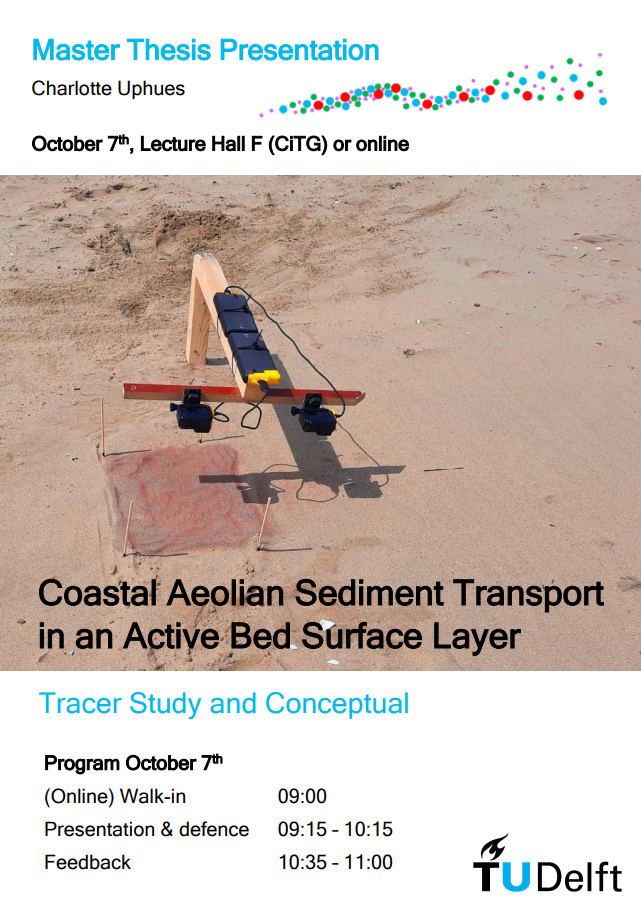Graduation of Charlotte Uphues
07 October 2021 09:00 till 11:00 - Location: CiTG, Lecture Hall F - By: Webredactie | Add to my calendar
Coastal Aeolian Sediment Transport in an Active Bed Surface Layer: Tracer Study and Conceptual Model
-
Professor of graduation: Dr.ir. S. de Vries (Delft University of Technology)
-
Supervisors: M.Sc. C.O. van IJzendoorn (Delft University of Technology), Dr.ir. B.C. van Prooijen (Delft University of Technology), Dr. G. Miot da Silva (Flinders University), Ir. S.G. Pearson (Delft University of Technology, Deltares), Dr.ir. E.C. Hallin (Lund University, Delft University of Technology)
Coastal aeolian sediment transport processes are influenced by supply limiting factors such as sediment sorting. Lighter, finer grains get eroded relatively quickly because they are easier to mobilize by the fluid drag force, while coarser particles are left behind and move slower. Such sorting processes can cause a coarsening of the bed surface and influence the formation of aeolian ripples. However, it is not fully understood what influence and importance sorting processes have on the magnitude of aeolian sediment transport. In this study, the concept of an Active Bed Surface Layer (ABSL) in which sand grains interact with the wind and cause sorting is introduced. This concept enables to better analyse transport processes of differently sized grains near and at the bed including sediment sorting and can help to improve sediment transport predictions. The transport processes in the ABSL are investigated by performing fieldwork using tracers. Subsequently, the findings of the fieldwork are further used to establish a conceptual model that relates the characteristics of the transport processes in the ABSL to their influence on the magnitude of aeolian sediment transport. Several tracer experiments were conducted in the area between the intertidal zone and the dune toe at Noordwijk beach in the Netherlands for different wind speeds with an onshore component. Sand grains were painted in different colors according to particle size and injected in an area of 30 cm x 30 cm with a thickness of 3 cm. Three cameras tracked the sand color movement on the bed surface. Surface samples were also taken 0.5 m, 2 m, and 4 m downwind of the injection site and analyzed with a digital microscope. Additionally, wind speed and direction were measured to relate the findings to the concurrent environmental conditions. The results show that for medium wind conditions, the tracer sand interacted with the sediment entering the test site from upwind direction, forming aeolian ripples with coarser grains on the ripple crests and smaller grains in the ripples troughs. Once the ripples have formed, the supply of finer tracer grains in downwind direction decreased over time, while the supply of coarser grains remained constant. A strong linear relationship between ripple propagation speed and wind speed was found. For higher wind velocities, no ripples or differences in transport of different grain size fractions in downwind direction were observed. Alternating phases of erosion and deposition of upwind sand were observed after the tracer sand got partly eroded. These phases could not be related to local gradients in wind speed. Based on these results and additions from literature, the most important characteristics in the ABSL are explained using a conceptual model with two regimes corresponding to moderate (I), and high (II) wind speeds. These characteristics are further used to estimate their influence on the magnitude of aeolian sediment transport. For Regime I, the supply of bed sediment for saltation is limited due to the formation of ripples in the ABSL and a linear relationship between sediment transport and wind speed is suggested to estimate the magnitude of aeolian sediment transport. The dynamics of the ABSL of Regime II are mainly influenced by the supply of upwind sediment and spatiotemporal variations in wind speed. A third power relationship between sediment transport and wind speed in combination with a process-based model that accounts for supply limitations seems suitable for making aeolian sediment transport predictions. This conceptual model of the ABSL with its two regimes describes aeolian sediment transport as a function of wind speed, bed characteristics, and upwind sediment supply. It differs from conventional aeolian sediment transport models, which only distinguish between transport and no transport and describe changes in sediment transport solely due to changes in wind speed. Thus, it can help to improve future sediment transport predictions and aeolian sediment transport models.
